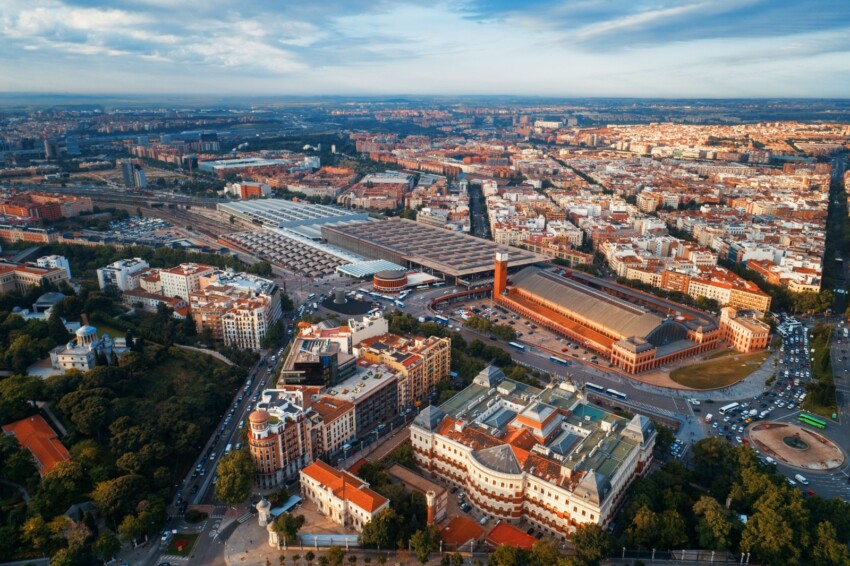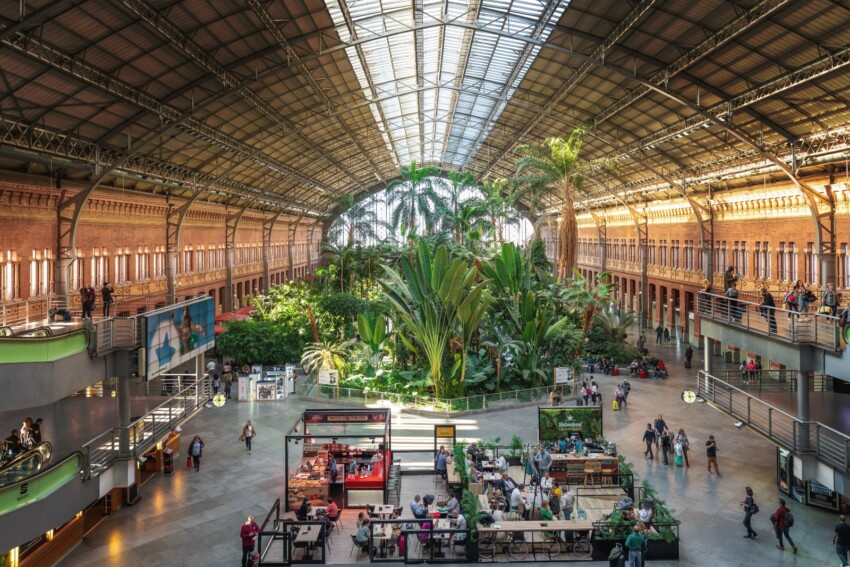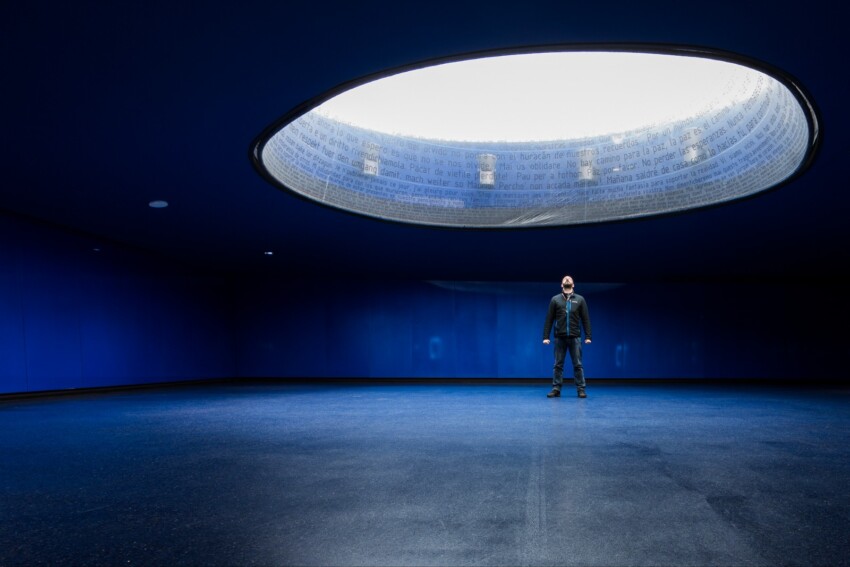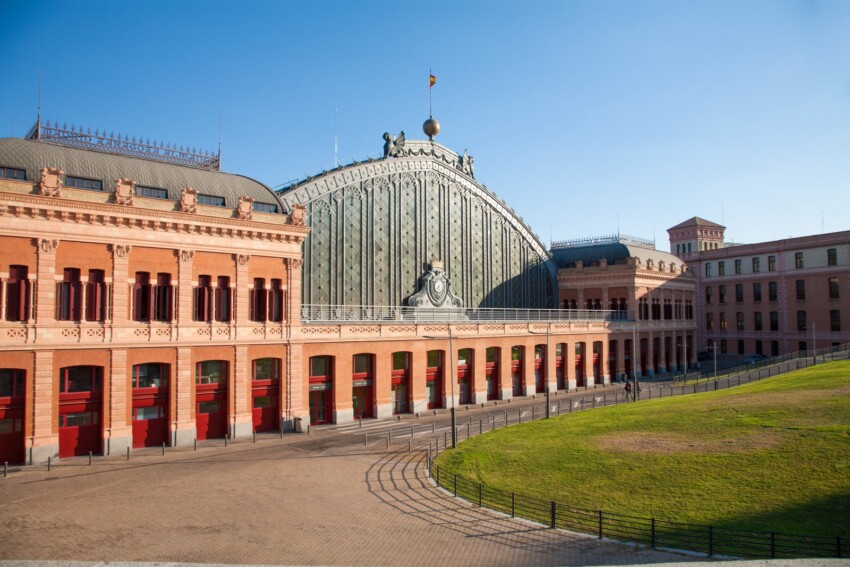

The oldest, the most important, the busiest and the greenest: we are talking about Atocha, the railway station that has become a major tourist attraction in Madrid.
A stone’s throw from the Prado Museum, the building that houses the Atocha station is an architectural masterpiece that effectively combines modern solutions with the romantic charm of the first railways.
It will not be difficult for you to recognise the unmistakable touch of Gustave Eiffel, author of the famous tower that bears his name in Paris, but other important engineers and architects have contributed over the decades to make this station special.
The huge station, which has about 15 million passengers a year, is now divided into two distinct areas: the new station, from which trains depart and arrive, and the old station, home to offices, shops and a bizarre tropical garden.
Come here for some fresh air, shopping, coffee or – why not? – board a train to your next destination. After all, in every station the real stars are the trains.

It is quite unusual for people to choose to spend some time inside a station, which are generally considered only places of passage, but Atocha is a special case.
What is the reason why so many Madrileños come here even if they don’t have to take any trains? Inside the Atocha station, a permanent botanical garden has been created from the space of the old tracks.
Thousands of plants, including palm trees, aquatic plants and exotic plants, grow inside the station’s glass and steel structure. Some animal species also live here: the turtles of the Atocha station have become famous.
With its constant temperature of around 24 degrees, the Atocha garden is an ideal refuge against the scorching heat of the city in the summer months or an unusual snowfall in the winter months.

Outside the Atocha station stands at the centre of a roundabout the Monument to the Victims of 11 March 2004, a touching tribute to the 191 people who lost their lives in the 11 March 2004 attack, unveiled exactly three years after the terrorist attack.
The monument is an 11-metre high cylindrical glass dome covered on the inside with a layer of etfe, a light and transparent material that allows engraving. Engraved on the layer of efte are messages of solidarity from the population in memory of the victims of the tragic event. The design allows natural light to filter through the glass, creating a solemn and reflective atmosphere. It is a symbol of memory and peace, located in the heart of the affected station.
After paying due homage to this touching monument, you can walk to the city’s main tourist attractions.
The city’s three major museums, the Prado, the Museo Nacional Reina Sofía and the Museo Thyssen-Bornesmiza, can be easily reached by walking up what is known as the Paseo del Arte. Also nearby is the Retiro Park, the city’s green lung, and the lively, multi-ethnic Lavapies district.

Atocha is one of the most important railway junctions in Spain: all long-distance and high-speed trains, regional trains (Cercanías network) and the metro ligero (ML1) depart from here, with which you can reach Madrid-Barajas airport. The Atocha-Renfe (L1) metro station is accessed internally from the railway station.
Two very special trains also depart from Atocha, of particular interest to tourists:
Atocha station is located in the Plaza del Emperador Carlos V, south of the historical centre. The square marks the southern end of the Paseo del Prado, and although it looks very close on the map, getting to Puerta del Sol by foot means walking for about 30 minutes.
Alternatively, Atocha station is served by Madrid’s metro line 1, which passes through the centre and some of the city’s most important attractions.
There is no shortage of places to sleep around Atocha station: from 4-star hotels from the Hard Rock, NH, Marriott and Radisson hotel chains to small family-run establishments, you are sure to find the perfect accommodation for you and your budget.
Atocha station was inaugurated on 9 February 1851: at the time it was a simple wooden platform, built to facilitate the boarding and alighting of passengers on Spain’s second railway line, which connected Madrid and Aranjuez, a municipality in the Comunidad Autonoma de Madrid known for its royal palaces and gardens.
The first extension works were carried out between 1865 and 1892, directed by Alberto del Palacio Elissagne with the collaboration of Gustave Eiffel: one of the station’s distinctive features, the roof of the main aisle, dates back to this period. 158 metres wide, 48 metres long and 27 metres high, it is one of the symbolic images of Madrid.
New changes were made between 1984 and 1992 under the direction of Rafael Moneo, one of the most important contemporary Spanish architects.
Further major renovations were carried out following the bombing that seriously damaged the station in 2004.
The Atocha railway station is located south of the centre of Madrid, close to the Lavapiès district and south of the Retiro Park. Very close to it is the Reina Sofia museum.
City Card allow you to save on public transport and / or on the entrances to the main tourist attractions.
